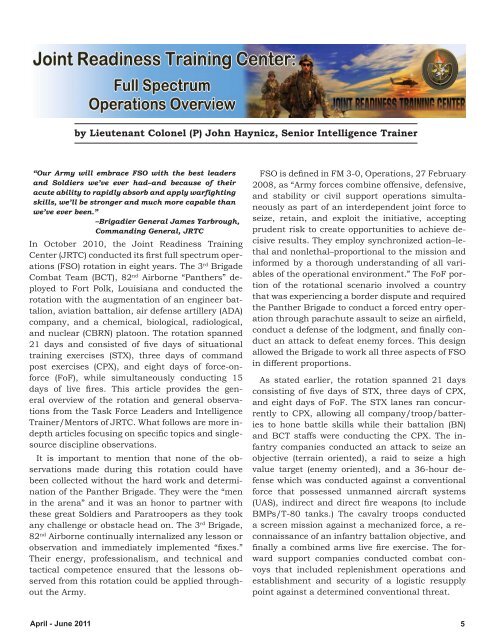George w. casey jr. - Federation of American Scientists
George w. casey jr. - Federation of American Scientists
George w. casey jr. - Federation of American Scientists
You also want an ePaper? Increase the reach of your titles
YUMPU automatically turns print PDFs into web optimized ePapers that Google loves.
y Lieutenant Colonel (P) John Haynicz, Senior Intelligence Trainer<br />
“Our Army will embrace FSO with the best leaders<br />
and Soldiers we’ve ever had–and because <strong>of</strong> their<br />
acute ability to rapidly absorb and apply warfighting<br />
skills, we’ll be stronger and much more capable than<br />
we’ve ever been.”<br />
–Brigadier General James Yarbrough,<br />
Commanding General, JRTC<br />
In October 2010, the Joint Readiness Training<br />
Center (JRTC) conducted its first full spectrum operations<br />
(FSO) rotation in eight years. The 3 rd Brigade<br />
Combat Team (BCT), 82 nd Airborne “Panthers” deployed<br />
to Fort Polk, Louisiana and conducted the<br />
rotation with the augmentation <strong>of</strong> an engineer battalion,<br />
aviation battalion, air defense artillery (ADA)<br />
company, and a chemical, biological, radiological,<br />
and nuclear (CBRN) platoon. The rotation spanned<br />
21 days and consisted <strong>of</strong> five days <strong>of</strong> situational<br />
training exercises (STX), three days <strong>of</strong> command<br />
post exercises (CPX), and eight days <strong>of</strong> force-onforce<br />
(FoF), while simultaneously conducting 15<br />
days <strong>of</strong> live fires. This article provides the general<br />
overview <strong>of</strong> the rotation and general observations<br />
from the Task Force Leaders and Intelligence<br />
Trainer/Mentors <strong>of</strong> JRTC. What follows are more indepth<br />
articles focusing on specific topics and singlesource<br />
discipline observations.<br />
It is important to mention that none <strong>of</strong> the observations<br />
made during this rotation could have<br />
been collected without the hard work and determination<br />
<strong>of</strong> the Panther Brigade. They were the “men<br />
in the arena” and it was an honor to partner with<br />
these great Soldiers and Paratroopers as they took<br />
any challenge or obstacle head on. The 3 rd Brigade,<br />
82 nd Airborne continually internalized any lesson or<br />
observation and immediately implemented “fixes.”<br />
Their energy, pr<strong>of</strong>essionalism, and technical and<br />
tactical competence ensured that the lessons observed<br />
from this rotation could be applied throughout<br />
the Army.<br />
FSO is defined in FM 3-0, Operations, 27 February<br />
2008, as “Army forces combine <strong>of</strong>fensive, defensive,<br />
and stability or civil support operations simultaneously<br />
as part <strong>of</strong> an interdependent joint force to<br />
seize, retain, and exploit the initiative, accepting<br />
prudent risk to create opportunities to achieve decisive<br />
results. They employ synchronized action–lethal<br />
and nonlethal–proportional to the mission and<br />
informed by a thorough understanding <strong>of</strong> all variables<br />
<strong>of</strong> the operational environment.” The FoF portion<br />
<strong>of</strong> the rotational scenario involved a country<br />
that was experiencing a border dispute and required<br />
the Panther Brigade to conduct a forced entry operation<br />
through parachute assault to seize an airfield,<br />
conduct a defense <strong>of</strong> the lodgment, and finally conduct<br />
an attack to defeat enemy forces. This design<br />
allowed the Brigade to work all three aspects <strong>of</strong> FSO<br />
in different proportions.<br />
As stated earlier, the rotation spanned 21 days<br />
consisting <strong>of</strong> five days <strong>of</strong> STX, three days <strong>of</strong> CPX,<br />
and eight days <strong>of</strong> FoF. The STX lanes ran concurrently<br />
to CPX, allowing all company/troop/batteries<br />
to hone battle skills while their battalion (BN)<br />
and BCT staffs were conducting the CPX. The infantry<br />
companies conducted an attack to seize an<br />
objective (terrain oriented), a raid to seize a high<br />
value target (enemy oriented), and a 36-hour defense<br />
which was conducted against a conventional<br />
force that possessed unmanned aircraft systems<br />
(UAS), indirect and direct fire weapons (to include<br />
BMPs/T-80 tanks.) The cavalry troops conducted<br />
a screen mission against a mechanized force, a reconnaissance<br />
<strong>of</strong> an infantry battalion objective, and<br />
finally a combined arms live fire exercise. The forward<br />
support companies conducted combat convoys<br />
that included replenishment operations and<br />
establishment and security <strong>of</strong> a logistic resupply<br />
point against a determined conventional threat.<br />
April - June 2011 5















